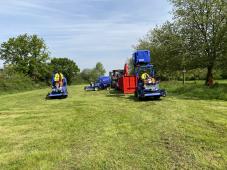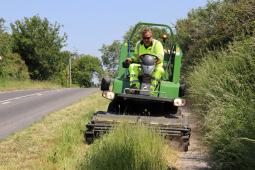Live Labs 2 blog - an update from the Greenprint project
This month’s Live Labs 2 project update comes from Steve Hill, Greenprint Stakeholder and Partnerships Lead for West Sussex County Council.
At this stage in our ambitious project, we have found it incredibly valuable and rewarding to look back at how far we have come and what we’ve managed to achieve in a relatively short space of time.
West Sussex and South Gloucestershire were granted funding from the Live Labs 2 programme to investigate innovative new ways of managing our roadside verges and open spaces. Greenprint has the potential to prove that small changes to how these green assets are managed can make substantial improvements to the environment we all share and live in. As well as the scientific and economic results, we have used the opportunity to explore how involving people with initiatives happening in their neighbourhood can influence a project’s success.
Encouraging feedback
Throughout the three-year Greenprint initiative we have engaged continuously with local communities in the areas of West Sussex and South Gloucestershire where we are experimenting with cut and collect verge management.
We sought their involvement and while there have been a few complaints, the positive feedback and support from parish councils and residents who welcomed the Greenprint trials in their neighbourhoods, has contributed to the project’s success.
In West Sussex, my community engagement approach has been to examine what outcomes and feedback develop from conversations with people in Horsham, Aldwick, Bersted and Pagham where the Greenprint cut and collect mowing regime is being trialled.
Rather than just relying on a website and emails to keep people informed, I visit all the main stakeholder organisation events, including parish, neighbourhood and council meetings, local networks, markets and village fetes. These in-person events give me the opportunity to explain our cut and collect trials, answer any immediate questions that come up and collect ideas and opinions about what we’re doing.
This approach has been widely positive and has resulted in:
- an ‘open door’ for feedback, comments and conversations
- stakeholders being able to decide when and where they want to engage with our project team
- the linking of Greenprint activities to local environmental projects where possible
- enabling people to complain (a little or a lot!) and the ability to deal with their concerns swiftly
The Greenprint sites in West Sussex and South Gloucestershire offer a range of different environments which in turn led to the need for varying approaches to community engagement.
In West Sussex, we chose to test roadside verges that are relatively close together in both urban and rural settings. While the South Gloucestershire green sites are distributed around the county in urban and semi-urban locations, including dual carriageways.
Like West Sussex, South Gloucestershire contacted communities regularly to keep them updated. While carrying out a trial on a dual carriageway, testing different equipment in a new environment, they simultaneously collected data on litter contamination in the cut grass. This followed on from litter surveys carried out by Keep Britain Tidy, where 50-metre-long sections of verges were sampled to get an idea of litter types within the seven parishes across the Greenprint sites. This aspect of the project’s research was important because cut grass contaminated by packaging, cigarette ends and plastic bags can be unsuitable for green energy recovery processing using anaerobic digestion.
Although the cut and collect verges are subject to a litter inspection and pick before cutting, the Keep Britain Tidy surveys revealed valuable data about the volume and types of litter that collects on verges across different neighbourhoods.
Community engagement moving forwards
Our community engagement has shown us that local people are proud that their local area has been chosen to be part of an innovative, national project. They’re eager to hear about our successes, the lessons we’ve learned and how these will shape the future. That enthusiasm has inspired our upcoming end-of-project roadshow across West Sussex.
In 2026, we will be touring the county, bringing along our experts, mowers, biochar samples, statistics and plenty of wildflower seeds to giveaway. The roadshow will be hosted in our fully equipped gazebo and will share the story of the Greenprint approach to road verge management, highlighting the many benefits it offers for local communities, wildlife and the wider environment.
There is no doubt that the Greenprint project has improved the reputations of the councils involved, especially around the areas of communication and engagement. Our efforts throughout have strengthened links with individuals, communities, business and all kinds of grass-roots environmental groups as well. It has helped spread the word about the positive difference people can make by working for, rather than against, their local environment. This means that regardless of the outcome of the scientific studies or commercial viability of the project, Greenprint has already been a success.
Further information
- To find out more about the Greenprint project, subscribe to Greenprint’s quarterly newsletter
- You can also visit the two project websites: www.southglos.gov.uk/greenprint and www.westsussex.gov.uk/greenprint
- LinkedIn - West Sussex County Council
Author
- Steve Hill is a Greenprint Stakeholder and Partnerships Lead for West Sussex County Council.


